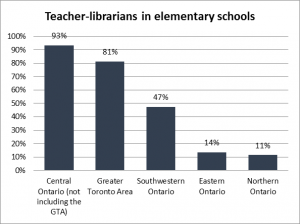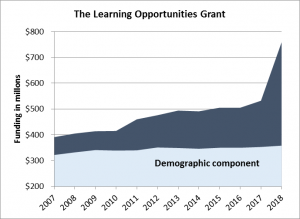New report highlights competing priorities in education
Annual report on Ontario’s schools shows decline in library staff, music teachers; improvements in Indigenous education
For immediate release
TORONTO (June 5, 2017) – A new report from People for Education – based on survey results from more than 1,000 Ontario schools – reveals ongoing challenges in a number of areas, including demands created by competing and overlapping provincial initiatives, ongoing regional inequities, and growing gaps in schools’ fundraising.
The report shows a decline in specialist library and music teachers, but a substantial improvement in Indigenous education programs.
Specialized staff on the decline in many schools
School boards receive the majority of their funding based on enrolment, and survey findings suggest that this puts boards with a high number of smaller schools at a disadvantage. In 2017:
Libraries
- Only 52% of elementary schools have a teacher-librarian, either full- or part-time – a decline from 60% in 2008, and 80% in 1998.
 68% of secondary schools have teacher-librarians – a decline from 76% in 2008.
68% of secondary schools have teacher-librarians – a decline from 76% in 2008.- Elementary schools in central Ontario are over 8 times more likely to have teacher-librarians compared to those in northern Ontario, where only 11% of elementary schools have these specialized staff.
- Reports from Queen’s University and others have shown that students in schools with teacher-librarians are more likely to report they like to read. Extensive research has found that students who enjoy reading are more likely to do better in school.
Guidance
- While 99% of secondary schools have guidance counsellors, only 23% of elementary schools with grades 7 and 8 have them. Students in grades 7 and 8 are choosing coursed for high school, and often struggling with transitions.
- 44% of elementary schools in the GTA have guidance counsellors, compared to 11% of schools in northern Ontario.
- Recent reports have found multiple, overlapping policies and initiatives that include a range of responsibilities for guidance counsellors, resulting in a lack of clarity around their role and a strain on guidance resources.
Health and Physical Education
- 42% of elementary schools have a specialist health and physical education teacher, compared to 44% in 2008. The majority are part-time.
- 73% of elementary schools in the GTA have health and physical education teachers, compared to only 30% in northern and 15% in eastern Ontario.
- Studies have found that students often have better health outcomes when they are taught by a health and physical education specialist compared to a classroom teacher.
Fundraising gaps
All schools report that parents, students and staff fundraise, but the amounts range from $0 to $200,000 per school. In 2017:
- The top 5% of fundraising secondary schools raise as much as the bottom 83% combined.
- For every $1 raised by the bottom 10% of elementary schools, the top 10% raised $49 – a significant increase from 2008, when the ratio was $1 to $25.
- 48% of elementary schools reported that they raised money for learning resources.
Indigenous education improves
The results from this year’s survey show a substantial improvement in Indigenous educational opportunities. According to the report, the improvement reflects the province’s commitment to implementing the “Calls to Action” from Canada’s Truth and Reconciliation Commission. The province has also implemented funding and policy aimed at increasing all students and educators’ knowledge about the “rich cultures and histories” of Indigenous peoples and improving educational outcomes for Indigenous students. In 2017:
- 66% of elementary and 80% of secondary schools offer Indigenous education opportunities, including things like language programs, guest speakers, and professional development for teachers. This is an increase from 49% and 61% respectively, since 2013.
- 51% of elementary and 61% of secondary schools offer professional development in Indigenous education – an increase from 34% in 2013.
Equity grant diluted
In 1998, the province introduced the Learning Opportunities Grant to provide greater financial assistance to boards with higher proportions of students whose socio-economic status meant they were more likely to be deemed ‘at-risk’ of academic failure or disengagement.
This year, People for Education examined how the grant had changed, and found that while the total funding in the grant has increased substantially since it was introduced, the proportion of the grant based on demographics has declined. When it was introduced, 100% of the grant was allocated to school boards based on the percentage of students whose socio-economic status put them at risk of struggling in school. By 2008 that proportion had declined to 82%, and in 2018 it will be 47%.
According to the report, the funding changes have resulted in a shift away from the grant’s original purpose of redistributive equity, to a greater focus on improving students’ scores in literacy and numeracy.
Recommendations for change
The report included four overall recommendations. People for Education recommended that the province:
- substantially revise the funding formula so that it provides equitable support and opportunities for all students, no matter where they live.
- undertake a review to evaluate and rationalize the plethora of overlapping programs, and develop a coherent approach so that all initiatives share common language and common goals.
- divide the current Learning Opportunities Grant into two grants – one focused on student success, and one specifically focused on redistributive equity. The new “equity in education grant” should support resources, programs, opportunities and strategies that have been shown to mitigate the impact of socio-economic factors on students’ chances for success in school.
- establish a new set of relevant indicators of student success that are more congruent with the interests, needs, and motivation of Indigenous communities, and vital for students’ success in school and life.
For more information please call People for Education at 416-534-0100.

